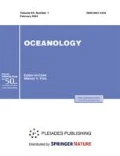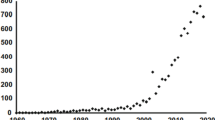Abstract
This article presents a data set on ash, proteins, lipids, carbohydrates, chitin, organic carbon (OC), total nitrogen (TN) and total phosphorus (TP) contents, macronutrients ratio (C, N, and P) and energy content of zooplankton (size fraction >500 μm) from the Kara Sea. Zooplankton samples were collected at 22 stations during the 76th interdisciplinary cruise of the R/V “Akademik Mstislav Keldysh” in July 2019. Proteins constituted the main component of zooplankton dry weight (43.39 ± 2.57% DW), while lipids amounted to 26.67 ± 2.28% DW and carbohydrates reached 4.91 ± 0.49% DW. Ash and chitin contents were 18.78 ± 1.39% and 3.68 ± 0.37% DW, respectively. The concentrations of macronutrients (C, N, and P) corresponded to the values of Arctic zooplankton and averaged 47.52 ± 1.12% for OC, 7.34 ± 0.39% for TN, and 0.70 ± 0.04% for TP of DW. The contribution of the individual components of the biochemical composition of zooplankton of the Kara Sea to the total OC revealed the dominant role of not only lipids but also proteins as compounds used by zooplankton in organic carbon accumulation. The Redfield ratio varied widely. The average values of C6.6:N, C70:P and N10.5:P were low and reflected certain features of the biochemical composition of the Kara Sea zooplankton community in the spring. The energy content of zooplankton of the Kara Sea ranged from 18.3 to 25.58 J mg-1 and averaged 20.25 ± 0.53 J mg-1 DW. The proportions of lipids and proteins in the total energy reserve of zooplankton were ~47 and ~46%, respectively, while the share of carbohydrates, their derivatives and chitin amounted to ~7%.

Similar content being viewed by others
REFERENCES
A. I. Agatova, N. M. Lapina, and N. I. Togunova, “Transformation rate of organic matter in ecosystems of Arctic seas,” in Arctic and Antarctica, Ed. by V. M. Kotlyakov (Nauka, Moscow, 2004), No. 3 (37), pp. 171–195.
E. G. Arashkevich, M. V. Flint, A. B. Nikishina, et al., “The role of zooplankton in the transformation of the organic matter in the Ob estuary, on the shelf, and in the deep regions of the Kara Sea,” Oceanology (Engl. Transl.) 50, 780–792 (2010).
V. I. Burenkov and A. P. Vasil’kov, “The influence of continental runoff on the spatial distribution of hydrological characteristics of the Kara Sea waters,” Okeanologiya (Moscow) 34, 652–661 (1994).
A. P. Vinogradov, “Chemical composition of marine plankton,” Tr. VNIRO 7, 97–112 (1938).
A. V. Drits, M. D. Kravchishina, A. F. Pasternak, et al., “Role of zooplankton in the vertical mass flux in the Kara and Laptev seas in fall,” Oceanology (Engl. Transl.) 57, 841–854 (2017).
A. G. Zatsepin, P. O. Zavialov, V. V. Kremenetskiy, et al., “The upper desalinated layer in the Kara Sea,” Oceanology (Engl. Transl.) 50, 657–667 (2010).
A. F. Pasternak, A. V. Drits, M. D. Kravchishina, and M. V. Flint, “Zooplankton impact on the organic matter flux of Siberian Arctic seas,” Dokl. Biol. Sci. 477, 232–235 (2017).
A. A. Polukhin and P. N. Makkaveev, “Features of the continental runoff distribution over the Kara Sea,” Oceanology (Engl. Transl.) 57, 19–30 (2017).
I. N. Sukhanova, M. V. Flint, S. A. Mosharov, and V. M. Sergeeva, “Structure of the phytoplankton communities and primary production in the Ob River estuary and over the adjacent Kara Sea shelf,” Oceanology (Engl. Transl.) 50, 743–758 (2010).
M. V. Flint, “Cruise 54th of the research vessel Akademik Mstislav Keldysh in the Kara Sea,” Oceanology (Engl. Transl.) 50, 637–642 (2010).
M. V. Flint, S. G. Poyarkov, N. A. Rimsky-Korsakov, and A. Yu. Miroshnikov, “Ecosystems of Siberian Arctic seas-2019: spring processes in the Kara Sea (cruise 76 of the R/V Akademik Mstislav Keldysh),” Oceanology (Engl. Transl.) 60, 134–137 (2020).
V. I. Shershneva and M. V. Koval’, “Caloric content of mass species of zooplankton and ichthyoplankton of the Kamchatka basin,” Izv. Tikhookean. Nauchno-Issled. Inst. Rybn. Khoz. Okeanogr. 139, 349–369 (2004).
N. V. Shumskaya, O. R. Uzbekova, V. Yu. Novikov, and V. A. Mukhin, “The role of microorgansisms in maintaining the chitin balance in the Barents Sea,” Appl. Biochem. Microbiol. 52, 558–563 (2016).
M. Alcaraz, R. Almeda, A. Calbet, et al., “The role of arctic zooplankton in biogeochemical cycles: respiration and excretion of ammonia and phosphate during summer,” Polar Biol. 33, 1719–1731 (2010).
U. Bamstedt, “Chemical composition and energy content,” in The Biological Chemistry of Marine Copepods, Ed. by E. D. S. Corner and S. C. M. O’Hara (Oxford University Press, Oxford, 1986), pp. 1–58.
S. Beier and S. Bertilsson, “Bacterial chitin degradation—mechanisms and ecophysiological strategies,” Front. Microbiol. 4, 149 (2013).
J. J. Beukema, “Caloric values of marine invertebrates with an emphasis on the soft parts of marine bivalves,” Oceanogr. Mar. Biol. Ann. Rev. 5, 387–414 (1997).
F. Carlotti, M. Krause, and G. Radach, “Growth and development of Calanus finmarchicus related to the influence of temperature: experimental results and conceptual model,” Limnol. Oceanogr. 38 (6), 1125–1134 (1993).
P. Carrillo, M. Villar-Argaiz, and J. M. Medina-Sánchez, “Relationship between N : P ratio and growth rate during the life cycle of calanoid copepods: an in situ measurement,” J. Plankton Res. 23 (5), 537–547 (2001).
C.-T. Chen, D. Bănaru, F. Carlotti, et al., “Seasonal variation in biochemical and energy content of size-fractionated zooplankton in the Bay of Marseille (North-Western Mediterranean Sea),” J. Mar. Syst. 199, 103223 (2019).
A. Clarke, L. J. Holmes, and D. J. Gore, “Proximate and elemental composition of gelatinous zooplankton from the Southern Ocean,” J. Exp. Mar. Biol. Ecol. 155 (1), 55–68 (1992).
T. L. Connelly, D. Deibel, and C. C. Parrish, “Elemental composition, total lipid content, and lipid class proportions in zooplankton from the benthic boundary layer of the Beaufort Sea shelf (Canadian Arctic),” Polar Biol. 35, 941–957 (2012).
T. Dittmar and G. Kattner, “The biogeochemistry of the river and shelf ecosystem of the Arctic Ocean : a review,” Mar. Chem. 83 (3–4). P. 103–120 (2003).
J. Donnelly, J. J. Torres, T. L. Hopkins, et al., “Chemical composition of Antarctic zooplankton during austral fall and winter,” Polar Biol. 14 (3), 171–183 (1994).
M. Edwards, “Plankton and global change, in Marine Plankton: A Practical Guide to Ecology, Methodology, and Taxonomy, Ed. by C. Castellani and M. Edwards (Oxford University Press, Oxford, 2017), pp. 67–80.
J. J. Elser, R. W. Sterner, E. A. Gorokhova, et al., “Biological stoichiometry from genes to ecosystems,” Ecol. Lett. 3 (6), 540–550 (2000).
S. Falk-Petersen, P. Mayzaud, G. Kattner, et al., “Lipids and life strategy of Arctic Calanus,” Mar. Biol. Res. 5 (1), 18–39 (2009).
J. Folch, M. Lees, and G. H. Sloane-Stanley, “A simple method for the isolation and purification of total lipides from animal tissues,” J. Biol. Chem. 226 (1), 497–509 (1957).
M. Frederiksen, M. Edwards, A. J. Richardson, et al., “From plankton to top predators: bottom-up control of a marine food web across four trophic levels,” J. Anim. Ecol. 75 (6), 1259–1268 (2006).
B. Gaye, K. Fahl, L. A. Kodina, et al., “Particulate matter fluxes in the southern and central Kara Sea compared to sediments: bulk fluxes, amino acids, stable carbon and nitrogen isotopes, sterols and fatty acids,” Cont. Shelf Res. 27 (20), 2570–2594 (2007).
I. Gismervik, “Stoichiometry of some marine planktonic crustaceans,” J. Plankton Res. 19 (2), 279–285 (1997).
M. Harmelin-Vivien, D. Bӑnaru, C. R. Dromard, et al., “Biochemical composition and energy content of size-fractionated zooplankton east of the Kerguelen Islands,” Polar Biol. 42 (3), 603–617 (2019).
T. Ikeda, “Chemical composition and nutrition of zooplankton in the Bering Sea,” in Biological Oceanography of the Northern North Pacific Ocean, Ed. by A. Y. Takenouti (Idemitsu Shoten, Tokyo, 1972), pp. 433–442.
L. Jagadeesan, N. Arivuselvan, G. Thirumaran, et al., “Biomass and biochemical composition of zooplankton along the Arabian Sea, west coast of India,” Adv. J. Food Sci. Technol. 2 (2), 96–99 (2010).
C. Jeuniaux and M. F. Voss-Foucart, “Chitin biomass and production in the marine environment,” Biochem. Syst. Ecol. 19 (5), 347–356 (1991).
R. Lee, W. Hagen, and G. Kattner, “Lipid storage in marine zooplankton,” Mar. Ecol.: Prog. Ser. 307 (1863), 273–306 (2006).
N. V. Lobus, “Elemental composition of zooplankton in the Kara Sea and the bays on the eastern side of Novaya Zemlya,” Oceanology (Engl. Transl.) 56, 809–818 (2016).
N. V. Lobus, E. G. Arashkevich, and E. A. Flerova, “Major, trace, and rare-earth elements in the zooplankton of the Laptev Sea in relation to community composition,” Environ. Sci. Pollut. Res. 26 (22), 23044–23060 (2019).
N. V. Lobus, A. V. Drits, and M. V. Flint, “Accumulation of chemical elements in the dominant species of copepods in the Ob estuary and the adjacent shelf of the Kara Sea,” Oceanology (Engl. Transl.) 58, 405–415 (2018).
O. H. Lowry, N. J. Rosebrough, A. L. Farr, et al., “Protein measurement with the Folin phenol reagent,” J. Biol. Chem. 193, 265–275 (1951).
T. M. Main, D. R. Dobberfuhl, and J. J. Elser, “N:P stoichiometry and ontogeny of crustacean zooplankton: a test of the growth rate hypothesis,” Limnol. Oceanogr. 42 (6), 1474–1478 (1997).
P. Mayzaud and J. L. M. Martin, “Some aspects of the biochemical and mineral composition of marine plankton,” J. Exp. Mar. Biol. Ecol. 17 (3), 297–310 (1975).
M. Omori, “Weight and chemical composition of some important oceanic zooplankton in the North Pacific Ocean,” Mar. Biol. 3 (1), 4–10 (1969).
M. Omori and T. Ikeda, Methods in Marine Zooplankton Ecology (Wiley, New York, 1984).
J. A. Percy and F. J. Fife, “The biochemical composition and energy content of arctic marine macrozooplankton,” Arctic 34 (4), 307–313 (1981).
L. Postel, H. Fock, and W. Hagen, “Biomass and abundance,” in Zooplankton Methodology Manual, Ed. by R. Harris, P. Wiebe, J. Lenz, (Academic, London, 2000), pp. 83–192.
J. E. G. Raymont, J. Austin, and E. Linford, “Biochemical studies on marine zooplankton: I. The biochemical composition of Neomysis integer,” ICES J. Mar. Sci. 28 (3), 354–363 (1964).
J. E. G. Raymont and R. J. Conover, “Further investigations on the carbohydrate content of marine zooplankton,” Limnol. Ocenogr. 6 (2), 154–164 (1961).
J. E. G. Raymont, R. T. Srinivasagam, and J. K. B. Raymont, “The biochemical composition of Euphausia superba,” J. Mar. Biol. Assoc. U.K. 51 (3), 581–588 (1971).
E. A. Romankevich, Geochemistry of Organic Matter in the Ocean (Springer-Verlag, Berlin, 1984).
C. L. Scott, S. Kwasniewski, and S. Falk-Petersen, “Lipids and life strategies of Calanus finmarchicus, Calanus glacialis and Calanus hyperboreus in late autumn, Kongsfjorden, Svalbard,” Polar Biol. 23 (7), 510–516 (2000).
Siberian River Run-Off in the Kara Sea: Characterisation, Quantification, Variability and Environmental Significance, Ed. by R. Stein, K. Fahl, D.K. Fütterer, (Elsevier, Amsterdam, 2003).
D. K. Steinberg and M. R. Landry, “Zooplankton and the Ocean carbon cycle,” Annu. Rev. Mar. Sci. 9 (1), 413–444 (2017).
D. K. Steinberg and G. K. Saba, “Nitrogen consumption and metabolism in marine zooplankton,” in Nitrogen in the Marine Environment, Ed. by D. G. Capone, D. A. Bronk, and M. R. Mulholland, (Elsevier, Amsterdam, 2008), pp. 1135–1196.
K. W. Tang and D. T. Elliott, “Copepod carcasses: occurrence, fate and ecological importance,” in Copepods: Diversity, Habitat and Behavior, Ed. by L. Seuront (Nova Science, New York, 2014), pp. 255–278.
R. A. Vollenweider, “Elemental and biochemical composition of plankton biomass; some comments and explorations,” Arch. Hydrobiol. 105 (1), 11–29 (1985).
ACKNOWLEDGMENTS
We would like to thank the scientific staff and the crew of the R/V “Akademik Mstislav Keldysh” for their professional help and support during the 76th cruise. We are also grateful to the peer reviewers for their interest in the research, valuable comments and suggestions.
Funding
This work was performed in the framework of the state assignment of IO RAS (theme no. 0128-2019-0011, organization and financing of expeditionary research), and was supported by the Russian Science Foundation (Project no. 18-77-00064, macronutrients content determination) and the Russian Foundation for Fundamental Research (Project no. 18-05-60214 determination of the components of the biochemical composition of zooplankton).
Author information
Authors and Affiliations
Corresponding author
Rights and permissions
About this article
Cite this article
Lobus, N.V., Flint, M.V., Flerova, E.A. et al. Biochemical Composition and Energy Content in the Zooplankton of the Kara Sea. Oceanology 60, 778–786 (2020). https://doi.org/10.1134/S0001437020050136
Received:
Revised:
Accepted:
Published:
Issue Date:
DOI: https://doi.org/10.1134/S0001437020050136




